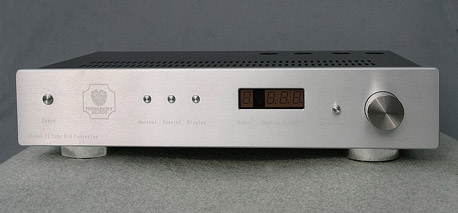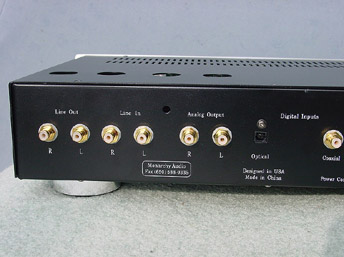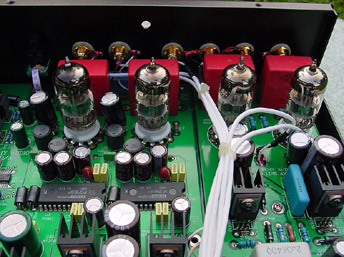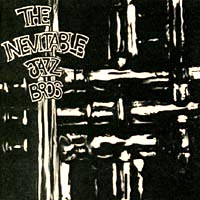Monarchy Audio M24 tube DAC/Line-stage
| Monarchy Audio M24 tube DAC/Line-stage |
| Music’s Magic on a budget! |
|
|
|
July 2006 |

What would you say if I told you that you could buy a near state-of-the-art tube DAC and a very good tube line stage preamplifier built on a single chassis for only $1490 USD? Personally, I’d say “Hooray!” I’m speaking of the new Monarchy Audio M24, and I’m dead serious.
The M24 is an integrated tube DAC and preamplifier that uses two toroidal power supplies and ten sections of power supply regulation for the separate digital and analog circuits. Not only does the M24 look good, but it’s very heavy for its size and is built like a tank on the inside, where it counts.
The M24 has two switched digital inputs, one SPDIF coaxial RCA, and one TOSLINK fiber optic. It can handle sampling rates from 16-bit/44.1kHz to 24-bit/96kHz, which are automatically recognized and displayed on the M24’s display window. This means the M24 will provide superb performance for all your redbook CDs and can also handle 24-bit, 48kHz or 96kHz PCM output from a typical DVD player. Hey, I just thought of another great use for the M24—you can play back DVD concerts in the PCM format and hear only the music without having to watch the accompanying inane video. The M24 will not support multi-channel SACD, DVD-A, or any surround modes, nor is the M24 compatible with MP3 or iPod formats. It works for me!
 Having an onboard tube line-stage with 16dB of gain, the M24 has a pair of analog RCA inputs for an additional source such as a phono stage or tape machine. There are two tubes in the DAC stage and two tubes in the line stage. There is also a direct DAC output for use with a separate preamplifier. The M24’s input and output options provide great flexibility in its use and for optimizing the sound to one’s system requirements and personal taste.
Having an onboard tube line-stage with 16dB of gain, the M24 has a pair of analog RCA inputs for an additional source such as a phono stage or tape machine. There are two tubes in the DAC stage and two tubes in the line stage. There is also a direct DAC output for use with a separate preamplifier. The M24’s input and output options provide great flexibility in its use and for optimizing the sound to one’s system requirements and personal taste.
 The M24 uses very high quality parts including the Burr Brown select grade PCM63P-K processor chip in conjunction with the DF1704 digital filter. The supplied tubes are military-grade 6DJ8s. Aesthetically, the M24 is rather elegant, with its thick gold anodized faceplate and laser-etched logo and button labels. The laser-etched labels are somewhat sedate and difficult to read. By contrast, the bright blue display that indicates the bit-rate and sampling frequency is large enough to be read across the room. The display is actually a bit too bright for my taste, so I normally switch it off. Adding a dimmer position might be a nice touch, but that’s a minor quibble.
The M24 uses very high quality parts including the Burr Brown select grade PCM63P-K processor chip in conjunction with the DF1704 digital filter. The supplied tubes are military-grade 6DJ8s. Aesthetically, the M24 is rather elegant, with its thick gold anodized faceplate and laser-etched logo and button labels. The laser-etched labels are somewhat sedate and difficult to read. By contrast, the bright blue display that indicates the bit-rate and sampling frequency is large enough to be read across the room. The display is actually a bit too bright for my taste, so I normally switch it off. Adding a dimmer position might be a nice touch, but that’s a minor quibble.
The M24 worked great from the get-go with very minimal tube noise in stasis with no music playing and your ear up to the speaker. The only anomaly of operation was the 2-minute standby cycle. At first I thought there was something wrong with the M24 because there was no sound coming from it. But after a couple of minutes I heard a faint click from the relay and the music began to play. Make a note of it!
Set Up
I initially installed the Monarchy M24 in my small, secondary reference system just to see if it had a shot. After a month or so of playing with it and discovering some of its virtues, I got the urge to bring it downstairs and see what it could do for my big rig.
Basically I replaced the Benchmark DAC1 with the M24. I used my trusty Rega Planet as a transport with my proven B&K Pro 10MC preamp as the line stage. My amplifiers are the new NuForce Reference 9SE monoblocks, which fed the VMPS RM30 speakers.
At first I ran the M24 through its own line stage through the B&K and found the sound to be very easy on the ears. It had a sweet-sounding midrange and highs and surprisingly well controlled bass (not as well controlled or quite as deep as the Benchmark, but quite satisfying, nonetheless). Overall, this configuration produced sound that was softer and more polite than the Benchmark with a slightly plump mid-bass character. It was certainly nice but I found it a little too laid back, with a slightly more forward midrange character. The line stage may not sound this way in every installation, because it sounded less laid back in my upstairs system using a different amplifier. As a matter of fact, I felt that the line stage of the M24 was a bit more coherent and natural sounding than that of my TAD-150 Signature preamp. As proof of that I sold the TAD-150 after being charmed by the M24.
That said, switching to the M24’s direct DAC outputs cranked the performance up a notch in both of my reference systems as well as my Stax SRS-4040 Signature System II headphone system. Tube rolling with this unit is definitely encouraged and recommended. I ended up putting a pair of Siemens ECC88 gold-pin tubes in the DAC stage, which managed to elicit a sound that suits my taste perfectly. Interestingly, I found the stock tubes to work quite well in the line stage. Your results may vary.
The sound of my system with the Siemens-equipped M24 became more immediate and palpable. The highs are so delicate, pure, and sweet that I wish I could take a picture of them and hang it on my wall. I’m sure it would add beauty to the room. Vocals and midrange instruments are still slightly more forward than the Benchmark, but made for a natural and immediate-sounding presentation. In addition, the smoothness and spot-on timbre of the M24 are qualities that many will savor. The bass became more similar in character to that of the Benchmark, but did not extend quite as deep. This was only evident with certain of my recordings that contained very deep bass and was not normally apparent. This direct-DAC configuration is the one I’ll be referring to in my listening impressions below.
Prelude
Fortunately, I had a very nice reference DAC in my system before I installed the Monarchy M24. I reviewed the Benchmark DAC1 (with the NuForce Ref 9 amps) right here at the Stereo Times not very long ago, and found it to be an extremely uncolored, low-distortion, and wide-bandwidth component. I have used it as my primary reference DAC ever since.
From a strictly technical standpoint, it is difficult to improve on the performance of the Benchmark DAC1. I’m not going to tell you that the Monarchy M24 has lower distortion, lower noise, or greater extension and power at the frequency extremes than the DAC1. The simple truth is that the Benchmark DAC1 is probably superior to the Monarchy M24 in all of those areas. Knowing Monarchy Audio’s C.C. Poon, my hunch is that the M24 was designed to excel in other ways—ways that would better express the emotion in the music rather than any claim to technical superiority.
More than that, due to the ease of tube-rolling with this unit and its different output stage options (direct DAC or volume-controlled line stage) listeners have more ways to tailor the sound to their own particular taste and system needs.
I must admit that it took me a long time to pull the Monarchy M24 out of my secondary reference system and install it in my primary system. In part, this was due to the fact that the M24 sounded so musically gratifying in the secondary system. The other part was my basic fear of tampering with the high level of sonic performance I had painstakingly achieved in my main system.
As with all things in life and in audio, tradeoffs abound. What would I gain, and what would I lose? In a system that I had carefully sculpted toward parameters of low distortion, wide dynamic range, focus and precision, what would I lose? That was my big question, and my dilemma, soon to be answered.
Let the music play
As it turned out, I lost a bit of bass extension and gained a small amount of mid-bass fullness, which I considered a fairly even swap. With most recordings, either DAC provided very satisfactory bass performance.
At the other end of the audible frequency spectrum, the high frequencies seemed a little smoother, and more natural, with a subtly softer character. This worked out rather synergistically with my NuForce 9SE amplifiers, which can sometimes sound a little bright due to their ultra-flat and extended high frequency response. I considered this aspect of performance an advantage for the M24.
For me, the true “clincher” came when listening to vocals, and many different midrange instruments. As I noted, the M24’s midrange presentation is slightly more forward and present than that of the Benchmark. In the concert hall this effect would be akin to moving from a center-hall seat to one a few rows closer to the performer(s). This also made a difference in the layering of the soundstage because the focus shifted more to the primary performers/instruments while quieter peripheral sounds were set a bit deeper into the background. But I was enjoying the M24’s more organic, up-front type of sound.
The other, more subtle aspect of the M24’s midrange reproduction is its ability to properly capture the decay of instrumental notes, in particular, that of the guitar. Listening to the Best of Chris Isaak CD [Reprise 49981-2],  I was stunned by just how “real” the guitars sounded. When “Baby Did A Bad Bad Thing” commenced, the powerful poignant notes of the bass guitar literally froze me in my tracks. As the crisp, clear, holographic notes sprang out of my speakers I remember thinking “I doubt if it sounded this good played live!” And on “only the lonely,” Chris’ dynamic, emotion-packed vocals accompanied by the rhythm guitar portrayed a very timeless and moving sound. Both the initial strumming on the strings and the sustained trail of the notes were skillfully rendered through the Monarchy M24. Indeed, I also noticed on other recordings that the M24 seemed particularly adept at reproducing the realistic decay of instrumental notes.
I was stunned by just how “real” the guitars sounded. When “Baby Did A Bad Bad Thing” commenced, the powerful poignant notes of the bass guitar literally froze me in my tracks. As the crisp, clear, holographic notes sprang out of my speakers I remember thinking “I doubt if it sounded this good played live!” And on “only the lonely,” Chris’ dynamic, emotion-packed vocals accompanied by the rhythm guitar portrayed a very timeless and moving sound. Both the initial strumming on the strings and the sustained trail of the notes were skillfully rendered through the Monarchy M24. Indeed, I also noticed on other recordings that the M24 seemed particularly adept at reproducing the realistic decay of instrumental notes.
 When playing “After You’ve Gone” from the Inevitable Jazz Bros CD (available at http://cdbaby.com/cd/ijbros) not only did the bass saxophone and the trumpet rule my world, but I never heard a banjo sound quite so natural, sweet, and convincing. The M24 took this already excellent recording to new heights that made me want to sit back and listen to every track on the disk. If you’re the type of audiophile that focuses on the naturalness and nuances of acoustic instruments, definitely put the M24 high on your must-hear list.
When playing “After You’ve Gone” from the Inevitable Jazz Bros CD (available at http://cdbaby.com/cd/ijbros) not only did the bass saxophone and the trumpet rule my world, but I never heard a banjo sound quite so natural, sweet, and convincing. The M24 took this already excellent recording to new heights that made me want to sit back and listen to every track on the disk. If you’re the type of audiophile that focuses on the naturalness and nuances of acoustic instruments, definitely put the M24 high on your must-hear list.
Caveats
I really don’t have a lot to complain about here. A couple of minor issues that come to mind are the display. It is either ON – blazing blue, or totally off. I think that Monarchy might have done better to add one dimmer position about half as bright as the fully lit position.
I also think that the laser-etched button labels add a touch of elegance to the faceplate, but are difficult to read. Then again, once you learn what the few buttons do, the labels are not all that necessary.
Conclusion
In my view the Monarchy M24 DAC/Line-stage is a remarkable product. The DAC or the tube line stage by itself would be worth Monarchy’s low $1490 price, but to get both units rolled into one very attractive component definitely strikes me as quite the sound bargain. The prospect of tube rolling in order to tailor the M24’s presentation to one’s personal taste is something that most audiophiles will welcome. I certainly enjoyed experimenting with different 6DJ8/6922-variety tubes that I had on hand.
If you’re looking for a DAC that will allow your system to sound smooth, natural, and musical, then the M24 should not be overlooked. Many audiophiles will recognize the value of being able to run a phono stage or other source component through the M24’s great-sounding tube line stage. Probably the highest compliment I can give is that the Monarchy DAC has replaced the Benchmark DAC1 in my reference system—not because it is more precise or revealing, but mainly because of its mesmerizing midrange virtuosity.
Frank Alles
______________
Specifications:
* Burr Brown select grade PCM63P-K used with
DF1704 digital filter
* An upgrade version of Monarchy Audio’s most
popular Model 22/33, with DAC and Line Amp
in one single package
* 24/96 compatible
* Auto detect 44.1 , 48 and 96 KHz sampling,
with front panel display
* Tube Analog stage in DAC section
* Military Grade 6DJ8 used in both the DAC and
Line Amp sections(4 pcs)
* Audiophile Grade Volume Control on Solid
Stainless Steel knob
* 10 Sections of fully regulated power supplies
* Separate toroidal transformers for the Digital
and Analog sections
* Separate Line Amp can be used with other
external inputs(Tape or Tuner, etc.)
* Gain = 16 dB
* DAC Direct Output for use with other Preamps
or Control Centers
* 117 or 230 Volt version available
Monarchy Audio
380 Swift Ave., #21
S. San Francisco, CA 94080
Voice: 650-873-3055
Fax: 650-588-0335
Email: monarchy@earthlink.net
Website: www.monarchyaudio.com
Monarchy M24 DAC/Line stage
Weight: 19 lbs.
Price: $1,490.00
![]()
Don’t forget to bookmark us! (CTRL-SHFT-D)
Stereo Times Masthead
Publisher/Founder
Clement Perry
Editor
Dave Thomas
Senior Editors
Frank Alles, Mike Girardi, Russell Lichter, Terry London, Moreno Mitchell, Paul Szabady, Bill Wells, Mike Wright, and Stephen Yan,
Current Contributors
David Abramson, Tim Barrall, Dave Allison, Ron Cook, Lewis Dardick, John Hoffman, Dan Secula, Don Shaulis, Greg Simmons, Eric Teh, Greg Voth, Richard Willie, Ed Van Winkle, Rob Dockery, Richard Doran, and Daveed Turek
Site Management Clement Perry
Ad Designer: Martin Perry





Be the first to comment on: Monarchy Audio M24 tube DAC/Line-stage